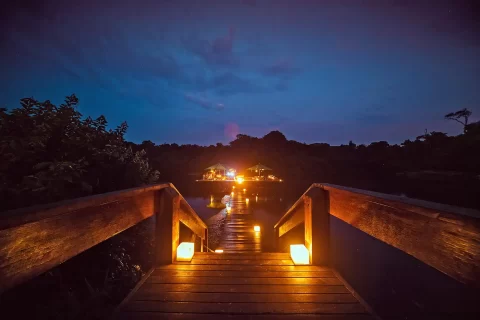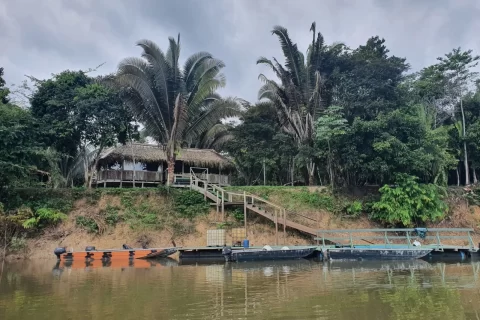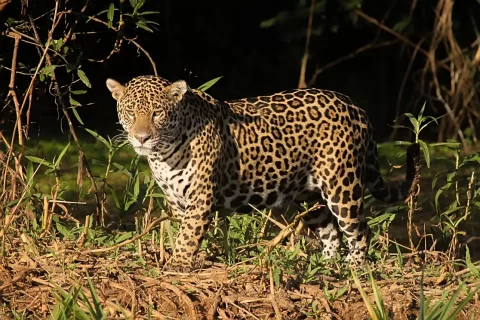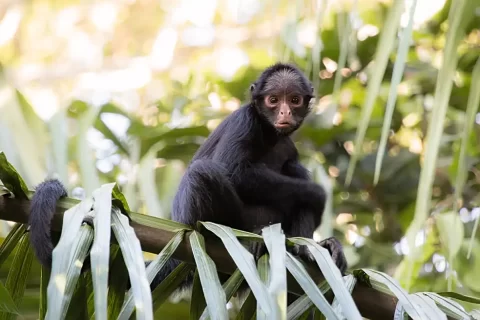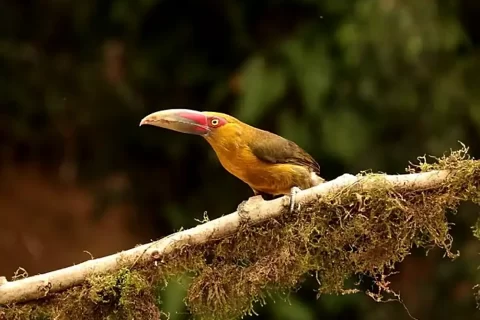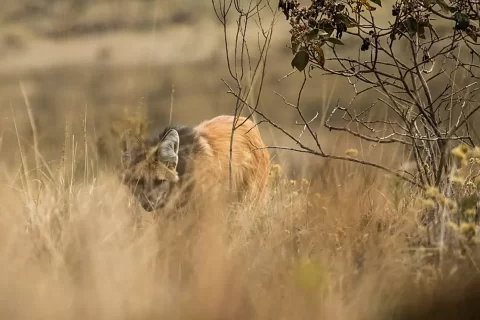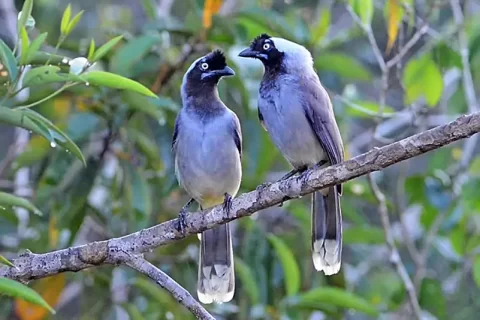Best time of year:
June – December
Duration:
13 days
Difficulty:
Fairly easy walking conditions. Hot, very humid climate. Long mornings in the field, but we typically have a down period after lunch.
Accommodations:
En-suite rooms with air-conditioning throughout the tour. In Manaus and Novo Airão we stay in comfortable hotels. In Presidente Figueiredo our hotel is simple, but close to the forest.
Starts in and Ends in: Manaus
Tour Overview
Our Heart of the Amazon tour begins in Manaus, a chaotic jungle metropolis which is like no other city in the world. Manaus exploded onto the world stage in the late 19th century thanks to the rubber boom which caused immigrants, wealth and disease to pour into the Amazon. Traces of that opulence mark the city today, including the famous Teatro Amazonas opera house, built at great expense at the peak of the boom. Remarkably for a city of its size (2 million inhabitants), there are still great tracts of Amazon rainforest surrounding the city, a boon for the birder. From Manaus we will bird two remarkable canopy towers in addition to visiting a vast reserve to bird tall terra firme Guianan Shield rainforest. A couple of hours to the north lies the small town of Presidente Figueiredo, where we bird more terra firme forest in addition to stunted white sand campinarana forest and shrubby campina habitats, highlighted by a visit to the spectacular lek of the Guianan Cock-of-the-Rock. With most of the Guianan Shield specialties under our belts, we head for the mighty Solimões river, spending an unforgettable day birding river islands, seasonal lakes, and beautiful oxbows. We’ll also bird a morning out of the town of Itacoatiara to look for two highly localized endemics not usually found on a standard tour to the region. To wrap it all up, two days will be spent birding the amazing Anavilhanas archipelago on the Rio Negro, a river so beautiful it will leave you speechless. Combine this tour with a week birding the mega-diverse forests of the Southern Amazon at Amazonia National Park or PiraAçu Lodge, or with a visit to the largest flooded forest reserve in the world, the amazing Mamirauá Reserve.
Itinerary
Day 1: Arrival in Manaus.
Arrival in Manaus, a bustling jungle metropolis unlike any other city in Brazil. We will stay in a comfortable hotel, either near the airport or in the upscale Ponta Negra neighbourhood of Manaus. Depending on arrival times, it may be possible to arrange a visit to the famous Teatro Amazonas opera house, a beautiful late 19th-century theater built during the peak of the Amazonian rubber boom. We could also visit a local park to look for the striking Pied Tamarin, a tiny primate that is essentially endemic to the Manaus metropolitan area.
Night in Manaus.
Day 2: Adolpho Ducke Reserve.
We begin the tour by spending the day birding the Adolpho Ducke Reserve on the outskirts of the city. The Ducke Reserve protects 10,000 hectares (25,000 acres) of primary and secondary terra firme forest, and it makes for an excellent introduction to the birds of the Guianan Shield. Specialties we’ll be searching for here include White-fronted Manakin, Red-billed Woodcreeper, Spot-winged Antbird and Gray-winged Trumpeter. We can take a mid-day break back at our hotel in the city before returning to the Ducke Reserve in the afternoon / evening to try for Tawny-bellied Screech-Owl and Rufous Potoo.
Night in Manaus.
Day 3: MUSA Canopy Tower and travel to Itacoatiara.
This morning we shall bird from the excellent canopy tower at the Museu da Amazonia (MUSA) Botanical Garden in Manaus. This 42-metre tower is extremely sturdy and offers good views over the MUSA forest reserve and the adjacent Adolpho Ducke Reserve. It is an eminently pleasant way to begin a trip to the region, and our privileged position will give us chances for a number of Guianan Shield terra firme specialties right off the bat: Guianan Puffbird, Guianan Toucanet, Green Aracari, Black-spotted Barbet, Waved Woodpecker, Paradise Jacamar and Red-fan Parrot could be spotted sitting in the treetops. Mixed species flocks of canopy birds often pass by the tower, and we’ll sort through these to find Black-bellied Cuckoo, Guianan Woodcreeper, Spot-backed Antwren, Glossy–backed Becard, and Buff-cheeked Greenlet. In the afternoon we drive for about four and a half hours to the town of Itacoatiara on the north bank of the Amazon river.
Night in Itacoatiara.
Day 4: Furo de Miracoera
In the morning we head upstream on the Amazon river to an area known as the Furo de Miracoera, a side channel on the north bank of the Amazon where we can get into some decent flooded varzea forest. Our major targets at Miracoera are the endemics Varzea Piculet and Scaled Spinetail, both of which are extremely difficult to find closer to Manaus. Another target to look for is the recently split Amazon river race of Ash-breasted Antbird, different from the birds we will see later in the tour on the Rio Negro. We can also expect to see Glossy Antshrike, Klages’s Antwren, White-eyed Attila, and with luck, Crimson-hooded Manakin. We’ll focus mostly on the two principal targets, though, as we have just this one morning to find them in. By late morning we’ll be back on the road, driving nearly all the way back to Manaus before turning north and heading to our next stop near the Tarumã-Açu river. The tracks near our hotel sometimes have Yellow-billed Jacamar, Ferruginous-backed Antbird and even Capuchinbird is a possibility.
Night north of Manaus.
Day 5: ZF-2 Canopy Tower. Travel to Presidente Figueiredo.
We depart early this morning to visit the Cuieiras Reserve administered by INPA (the National Institute for Amazonian Research). The reserve is often simply referred to as ZF-2 by birders, and the main attraction here is another remarkable canopy tower that offers 360° views over unbroken primary forest as far as the eye can see. Driving the rough dirt road to the tower at dawn is often an excellent way to spot shy birds such as Black Curassow and Gray-winged Trumpeter. Atop the tower we will be scanning the treetops for White Hawk, Caica Parrot, Pompadour Cotinga, Racket-tailed Coquette, Painted Tody-Flycatcher, Olive-green Tyrannulet, Dotted Tanager and Red-billed Pied Tanager. The forest below the tower sometimes produces rarities such as Black-throated Antshrike, Spotted Antpitta and Guianan Red-Cotinga. After having lunch in the field, we continue north to the small town of Presidente Figueiredo, arriving to our hotel in time for some afternoon birding in the forests around our lodge.
Night in Presidente Figueiredo.
Day 6 & 7: Presidente Figueiredo.
We have two full days to bird the terra firme and white sand forests around Presidente Figueiredo. The birding here is varied and exciting, and we will visit a number of sites in the area (including the forested grounds of the hotel where we stay) to search for some of the main specialties found here. These include a list of interesting cotingas including Guianan Red-Cotinga, Capuchinbird, and Pompadour, Spangled and Purple-breasted Cotingas, in addition to the spectacular Guianan Cock-of-the-Rock. Other terra firme targets include Yellow-billed Jacamar, Ferruginous-backed Antbird, Rufous-bellied Antwren, Brown-bellied Stipplethroat, Spotted Antpitta, and Wing-banded Wren. The stunted white sand campinarana forests and open sandy and rocky areas known as campinas host a different set of birds: White-naped Seedeater, Plumbeous Euphonia, Rufous-crowned Elaenia, Saffron-crested Tyrant-Manakin, Pelzeln’s Tody-Tyrant and Yellow-crowned Manakin are amongst the principal targets in these habitats. Visits to quiet tracks through tall forests around Presidente Figueiredo will target Glossy-backed Becard, Dusky Purpletuft, Guianan Gnatcatcher, Dotted Tanager and Amazonian Pygmy-Owl, amongst others.
Nights in Presidente Figueiredo.
Day 8: Presidente Figueiredo and return to Manaus.
We’ll have another full morning in the Presidente Figueiredo area to target any leftover Guianan Shield specialties before we return to Manaus in the afternoon. En route to Manaus we can visit an area to look for Crimson Topaz and Black-throated Antshrike. We overnight in a comfortable hotel in the industrial district.
Night in Manaus.
Day 9: River islands in the Solimões.
An early start will see us boarding a motorized boat before dawn, crossing the famed Meeting of the Waters – the confluence of the Solimões and Negro rivers to form the Amazon river proper – en route to a series of white-water islands upstream from Manaus. These whitewater river islands host a number of birds tied to specific successional habitats, and we have a full day to explore the various parts of the islands. The specialties we’ll be searching for here include Tui Parakeet, Short-tailed Parrot, Olive-spotted Hummingbird, Lesser Hornero, Dark-breasted, White-bellied, Parker’s and Red-and-white Spinetails, Castelnau’s Antshrike, Black-and-white Antbird, River Tyrannulet, Brownish Elaenia, and Yellow-hooded and Oriole Blackbirds. After a late lunch at a floating restaurant, we can take a walk on a short boardwalk to view the Victoria amazonica giant water lilies in a small oxbow where Zimmer’s Woodcreeper and Hoatzin can be found.
Night in Manaus.
Day 10: Travel to Novo Airão.
This morning we cross the Rio Negro to its west bank from Manaus. The drive to our destination, the small town of Novo Airão, normally takes about 3 hours, but we will break up this drive with a couple of birding stops, and a stop for lunch. We should arrive at our hotel in the mid-afternoon. After getting settled, we can drive to a quiet road through a nice area of forest to look for a number of species which we have not yet had a chance to see, as there is significant turnover between the terra firme forests east and west of the Rio Negro.
Night in Novo Airão.
Day 11 & 12: Anavilhanas National Park & West bank of the Rio Negro.
We have two full days at our disposal on the west bank of the Rio Negro, and we’ll focus on the blackwater river island avifauna, taking boat trips from Novo Airão into the Anavilhanas archipelago. Anavilhanas is a complex of river islands in the Rio Negro, the spectacularly beautiful blackwater tributary of the Amazon river. Anavilhanas comprises more than 400 river islands in an area greater than 350,000 hectares. The blackwater river islands host a subset of endemic and specialty bird species including Festive Parrot, Zimmer’s Woodcreeper, Ash-breasted Antbird (ssp. stictopterus, recently split by the Brazilian Checklist Committee) Black-chinned Antbird, Blackish-gray Antshrike, Leaden, Cherrie’s and Klage’s Antwrens. Other species we may encounter here include American Pygmy Kingfisher, Streak-throated Hermit, Green-tailed Goldenthroat, Green-tailed Jacamar, Long-billed Woodcreeper, Ringed Woodpecker, Cream-coloured Woodpecker, Scale-breasted Woodpecker, Black-crested Antshrike, Amazonian Tyrannulet, Amazonian Umbrellabird, Wire-tailed Manakin, and Orange-fronted Yellow-Finch. We should have the opportunity to spend some time birding forested tracks around Novo Airão, where we may find a number of species not likely elsewhere on the tour, including Maroon-tailed Parakeet, Gilded Barbet, Yellow-browed Antbird, Black-necked Red-Cotinga, White-browed Purpletuft, while other possibilities include rarities such as Chestnut-crested Antbird and Tawny-tufted Toucanet. We will also do some night birding in the area to look for Spectacled Owl and White-winged Potoo.
Nights in Novo Airão.
Day 13: Terra firme west bank Rio Negro. Return to Manaus.
With a full final morning available to us, we can choose whether to return to the river islands, or to visit a forest reserve where we can search for Collared Puffbird, Pearly Antshrike, White-cheeked Antbird and Black-headed Parrot. After lunch we pack up and return to Manaus.
End of tour.
Possible Extensions and Additions
Amazonia National Park
A short extension spending three and half days in Amazonia National Park, one of the best birding sites in the entire Brazilian Amazon. The park has several excellent birding trails into pristine terra firme rain forest with a rich variety of micro-habitats from vine-laden upland forests, to vast stands of açaí and babaçu palms, to stunted forests on sandier soils. The park bird list exceeds 500 species, headlined by one of the most spectacular birds in the Amazon, the stunning Golden Parakeet. Other evocative endemics include Pale-faced Bare-eye, Harlequin Antbird, Brown-chested Barbet, White-crested Guan and Black-bellied Gnateater. Certainly one of the most under-rated destinations in all of Brazil. Please see our Amazonia National Park itinerary for further details.
Uakari Lodge & Mamirauá
The Mamirauá Sustainable Development Reserve protects an area of 1.1 million hectares between the Japurá and Solimões rivers in the central-western Amazon. Mamirauá is the largest reserve protecting seasonally flooded várzea rainforest in the world. To explore Mamirauá, we stay at the unique Uakari Lodge: it floats in a hairpin bend of a blackwater river, surrounded by beds of floating vegetation, water hyacinths, Horned Screamers, and hulking Black Caimans. The lodge has been designed to make best use of sustainable practices, including use of solar energy, biological treatment of wastewater, and rainwater captation. We will have a private guide and canoe at our disposal during our time at Mamirauá. Our exploration of the other-worldly flooded forests will be very productive: birds we’ll be searching for include the rare and elusive Wattled Curassow, Zigzag Heron, Scarlet Macaw, Slender-billed Kite, White-eared Jacamar, Scarlet-crowned Barbet, Chestnut-capped Puffbird, Lafresnaye’s Piculet, Black-and-white Antbird, Plumbeous Antbird, Orange-fronted Plushcrown, Masked Crimson Tanager, Russet-backed Oropendola, Oriole Blackbird and much more. Mamirauá is also home to the most bizarre primate in the Amazon, the bald-headed, ruddy-faced White Uakari monkey, endemic to the flooded forests between the Japurá and the Solimões rivers. Other mammals we are likely to encounter include Pink River Dolphins, Vanzolini’s Squirrel Monkey, and Red Howler Monkey. Uakari Lodge is reached by a one-hour commercial flight from Manaus to the town of Tefé, followed by a 1.5 hour boat ride to the lodge.
PiraAçu Lodge
A sport-fishing lodge that has recently been discovered by birders, PiraAçu Lodge is surrounded by impressive Amazonian rainforest in all directions. Situated within the Madeira-Tapajós centre of endemism, a mouth-watering list of rarities have already been found here including Rondonia Bushbird, Nocturnal Curassow, Pale-faced Bare-eye, White-breasted Antbird and Buff-cheeked Tody-Flycatcher. There are two flights per week from Manaus to the town of Apuí, the nearest town to PiraAçu Lodge. From Apuí we travel 100 kilometres along the Transamazonica Highway to the banks of the Aripuanã river, where boats from PiraAçu await us for the 2.5 hour river trip upstream to the lodge. Please see our Remote Rio Aripuanã itinerary or our PiraAçu Lodge page for further details.









